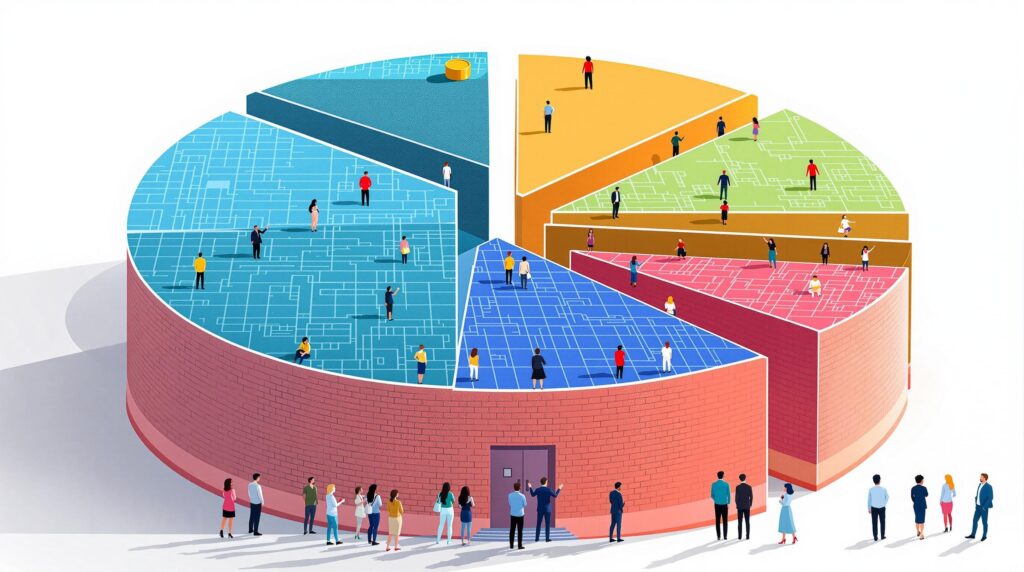[rev_slider alias=”slider-1″][/rev_slider]
Introduction to Top Layer 1 Blockchains
- Explanation of Layer 1 Blockchains: Layer 1 blockchains, often known as base layer or foundational blockchains, serve as the basic framework on which other applications and protocols are built. They function similarly to an operating system on a computer, allowing various decentralized applications (dApps) and services to run on top. Famous examples include Bitcoin and Ethereum, which have established robust ecosystems around them.
- Key Characteristics of Leading Layer 1 Blockchains: Leading Layer 1 blockchains possess several key characteristics that set them apart:
- Security: High levels of security are paramount. These blockchains use advanced cryptographic techniques to ensure data integrity and user privacy.
- Scalability: The ability to process numerous transactions per second is crucial for accommodating growing user bases.
- Decentralization: Distributing control across numerous nodes ensures no single entity has undue influence over the network.
- Interoperability: They often support interaction with other blockchains, enhancing utility and flexibility.
- Community Support: A robust community can drive adoption and ongoing development.
- Overview: Importance in the Decentralized Future: As we look to the future, Layer 1 blockchains play a pivotal role in the evolution of decentralized technologies. They serve as the backbone for innovations such as decentralized finance (DeFi), non-fungible tokens (NFTs), and various digital identity solutions. Their ability to provide a secure, scalable, and decentralized platform makes them indispensable in a digital economy that increasingly values trustless interactions and censorship resistance.
What is a Layer 1 Blockchain? A Layer 1 blockchain is the underlying architecture that establishes the protocol rules and structure for a blockchain network, enabling various applications to interact with its ecosystem.
Layer 1 blockchains like Bitcoin and Ethereum are foundational to the entire blockchain ecosystem, facilitating secure digital transactions and enabling the development of decentralized applications. With the digital transformation gaining momentum, these blockchains are poised to transform not only finances but also sectors like supply chain, healthcare, and governance.
Jara, positioned at the intersection of Africa’s rapid digital transformation, stands as a testament to how Layer 1 infrastructures can spearhead economic empowerment. With its proprietary blockchain, Jara aims to revolutionize the infrastructure gap by offering financial services access to millions, underpinned by robust Layer 1 blockchain technology.
Invest in $JARA: Fuel Africa’s $200B+ Digital Asset Economy and Participate in a Revolutionary Ecosystem.
Comparing Layer 1 and Layer 2 Blockchain Solutions
- Definitions and Differences: Layer 1 blockchain refers to the foundational architecture of a blockchain system. It includes the main chain that handles all transaction processes and serves as the base security layer. Layer 2 solutions, on the other hand, are built atop the Layer 1 blockchain to enhance scalability and efficiency by processing transactions off the main chain before ultimately settling them on Layer 1.
-
Pros and Cons of Layer 1 vs. Layer 2 Solutions:
- Layer 1 Advantages: Provides robust security and decentralization. It’s the backbone for any blockchain ecosystem, supporting transaction validation and data integrity.
- Layer 1 Disadvantages: Scalability issues can lead to slower transaction speeds and higher costs during peak usage.
- Layer 2 Advantages: Offers enhanced transaction speeds and lower costs, making the blockchain more efficient and user-friendly.
- Layer 2 Disadvantages: Potential trade-offs in security and decentralization because it operates on top of Layer 1.
-
Use Cases for Each Type:
-
Layer 1 Use Cases: Ideal for applications requiring high security and decentralization, such as cryptocurrency transactions and decentralized finance (DeFi) protocols. Popular examples include Ethereum and Bitcoin.
- Bitcoin-related legal considerations explore the implications of transaction security on Layer 1 blockchains.
-
Layer 2 Use Cases: Best suited for scaling decentralized applications (dApps) by allowing faster payments and reducing transaction congestion on the main network. Instances include solutions like the Lightning Network for Bitcoin and Optimistic Rollups for Ethereum.
- Cryptocurrency fraud defenses can illustrate the importance of Layer 2 solutions in protecting user assets by offering enhanced usability.
-
Layer 1 Use Cases: Ideal for applications requiring high security and decentralization, such as cryptocurrency transactions and decentralized finance (DeFi) protocols. Popular examples include Ethereum and Bitcoin.
Layer 1 blockchains are the original blockchain architectures that handle data validation, security, and consensus. Layer 2 solutions are additional protocols that improve scalability by processing transactions off the main blockchain.
Layer 1 blockchains are essential for security and basic transaction functionalities, while Layer 2 solutions enhance scalability and transaction speed by offloading some of the processing work.
In essence, while Layer 1 sets the stage with fundamental blockchain operations, Layer 2 solutions are emerging as critical players for scalability and efficiency improvements. By applying different protocols, they ease the burden on the main blockchain and open new avenues for technological innovations.
This section clearly compares Layer 1 and Layer 2 blockchain solutions, outlining their definitions, pros and cons, and use cases. It uses SEO strategies to optimize for related keywords while integrating contextual links and maintaining mobile-responsive HTML formatting.
[rev_slider alias=”text-call-cta”][/rev_slider]
Key Players in Layer 1 Blockchain Technology
- Review of Leading Layer 1 Blockchains: Layer 1 blockchains are the foundational networks within the blockchain infrastructure. These are the systems responsible for processing transactions and ensuring security without the need for additional modifications or additional layers. Key players leading this space include significant names like Bitcoin, Ethereum, and Binance Smart Chain. These networks have established themselves by delivering robust solutions facilitating millions of transactions daily across the globe.
- Bitcoin: Recognized as the pioneer of blockchain technology, Bitcoin remains at the forefront due to its decentralization and security. Bitcoin’s use as a store of value and its acceptance in various financial markets continues to highlight its importance. It operates through a consensus mechanism called Proof of Work (PoW), wherein nodes, known as miners, compete to validate transactions and secure the network.
- Ethereum: Ethereum has introduced smart contracts, revolutionizing how transactions are handled by enabling automatic executions upon meeting predefined conditions. The transition from a PoW to a more sustainable Proof of Stake (PoS) mechanism, known as Ethereum 2.0, is aimed at improving scalability and reducing environmental impact. Ethereum supports the burgeoning realm of Decentralized Finance (DeFi) applications, considerably contributing to its prominence.
- Binance Smart Chain (BSC): BSC has rapidly gained traction due to its low transaction costs and compatibility with Ethereum’s ecosystem. It leverages a Proof of Staked Authority (PoSA) consensus model, which combines elements of both PoW and PoS to facilitate swift and efficient transactions. This blockchain is particularly attractive to developers seeking to create decentralized apps (dApps) without the high gas fees associated with Ethereum.
What is a Layer 1 Blockchain? A Layer 1 Blockchain refers to the foundational protocol layer of a blockchain ecosystem, which includes consensus mechanisms and transaction validation directly on its primary chain.
Innovations and Technologies Advancing Layer 1
- Scalability Solutions: Layer 1 scalability remains a critical focus area, propelling innovations like sharding in Ethereum’s roadmap. Sharding segments the blockchain into smaller pieces, known as shards, thus permitting parallel transaction processing and reducing bottlenecks.
- Consensus Mechanism Evolution: Transitioning from PoW to PoS and hybrid models such as Delegated Proof of Stake (DPoS) is helping improve energy efficiency and transaction throughput. This evolution not only increases transaction speeds but also amplifies network security.
- Security Enhancements: Stronger cryptographic measures are continually being developed to protect blockchains from malicious attacks. Innovations in quantum-resistant algorithms ensure that these networks remain secure well into the future, even as potential computing threats evolve.
- Interoperability: Cross-chain technology facilitates seamless data and value transfer among distinct blockchains, enabling a highly-connected and functional decentralized ecosystem. Projects like Polkadot and Cosmos are pivotal in achieving interoperability through their respective protocols.
Impact on Global Decentralization Efforts
- Financial Inclusion: By lowering barriers to entry and enabling peer-to-peer financial transactions, Layer 1 blockchains are democratizing financial services, providing unbanked populations access to banking and growth opportunities. Whether it’s facilitating microtransactions or enabling smoother international remittances, their global reach is undeniable.
- Transparency and Trust: The transparency inherent in blockchain creates trustless environments where transactional data remains immutable and verifiable. This revolutionizes sectors such as supply chain management and asset tracking, ensuring credibility and traceability across all stages.
- Decentralized Governance: Layer 1 blockchains empower communities through decentralized governance models, where stakeholders participate in critical decision-making processes. This fosters a fairer, more inclusive ecosystem, promoting greater innovation and collaboration.
- Technological Adoption: With ongoing developments and reduced technology costs, more regions, such as Africa, are adopting blockchain solutions to support crucial sectors like finance, healthcare, and real estate. This widespread adoption is powerfully transforming socioeconomic landscapes by fostering new growth opportunities.
“Your Voice, Our Mission” – with blockchain at the helm, Jara is committed to advancing decentralization, ensuring your participation in a trustworthy and dynamic financial ecosystem.
As these leading players and innovations continue to shape global decentralization efforts, it’s essential to remain informed and engaged. To learn more about the role of cryptocurrencies in modern financial systems, visit this comprehensive guide on cryptocurrency legalities.
The Future of Decentralization with Layer 1 Systems
The world of blockchain technology is constantly evolving, with Layer 1 blockchains representing the backbone of decentralized applications and financial systems. Within this dynamic ecosystem, certain trends and challenges are shaping the future of decentralization, especially as we move towards more inclusive and efficient systems.
How are Layer 1 blockchains defined? Layer 1 blockchains are primary networks that provide the foundational architecture for building decentralized applications and conducting secure transactions directly on the blockchain without the need for additional layers.
Recent Trends and Developments
Recent trends in Layer 1 blockchains focus on enhancing scalability, security, and interoperability. As the demand for decentralized finance (DeFi) and non-fungible tokens (NFTs) grows, developers are pushed to innovate and provide solutions that address these market needs.
- Scalability Improvements: One of the main focus areas is scalability. Networks like Ethereum 2.0 are adopting proof-of-stake mechanisms to increase transaction throughput and reduce energy consumption.
- Interoperability Enhancements: Projects such as Polkadot and Cosmos are pioneering interoperability solutions, enabling different blockchains to communicate with each other seamlessly, which is crucial for a holistic decentralized ecosystem.
- Security Upgrades: With cyber threats on the rise, enhancing security protocols is paramount. This includes deploying more advanced cryptographic techniques to secure transactions and smart contracts.
Investing in innovation is key to the sustained growth of Layer 1 blockchains. For instance, Jara’s development of a proprietary Layer 2 blockchain demonstrates how focusing on strategic features can empower users while maintaining security and reliability.
Challenges Facing Layer 1 Blockchains
Despite advancements, Layer 1 blockchains face significant challenges. Some hurdles include the ongoing scalability battle, regulatory concerns, and energy efficiency issues, all of which require thoughtful solutions.
- Scalability Pressures: As transaction volumes increase, the need to process these efficiently without compromising security is more pressing than ever. Innovations like sharding and rollups are gaining traction as potential solutions.
- Regulatory Landscape: Global regulations remain a daunting challenge. Navigating diverse legal frameworks, especially with fluctuating compliance requirements, impacts the deployment and operation of blockchains significantly.
- Environmental Considerations: The energy consumption of proof-of-work blockchains like Bitcoin has attracted criticism. There is a strong push towards more eco-friendly consensus mechanisms such as proof-of-stake.
Why is scalability crucial for Layer 1 blockchains? Scalability determines a blockchain’s ability to handle a growing amount of work and accommodate an increasing number of users without compromising performance.
Predictions for Blockchain and Decentralization
Looking towards the future, we can expect several key developments in Layer 1 blockchains that will shape the broader landscape of decentralization. These include further enhancements in cross-chain capabilities, a surge in decentralized governance, and increasing integration with traditional financial systems.
- Cross-Chain Integration: More seamless cross-chain interactions will become a norm, facilitating fluid asset transfers and collaborations across different blockchain platforms.
- Decentralized Governance: Governance models that empower token holders to make decisions are expected to become more sophisticated, leading to truly decentralized networks driven by community interests.
- Traditional Finance Integration: As legacy financial institutions begin to adopt blockchain technology, we will see a blending of traditional and decentralized financial services, providing users with broader and more innovative options.
By participating in initiatives like Jara’s transformative projects, stakeholders can experience firsthand the potential of these technologies in driving inclusive and sustainable economic growth, particularly in rapidly developing regions such as Africa.
What does the future hold for blockchain technology? As we move forward, blockchain technology is expected to foster more robust decentralization, improved interoperability, and greater integration with traditional financial systems.
In conclusion, the future of Layer 1 blockchains remains promising with exciting developments on the horizon. As technology continues to advance, staying informed and involved will be key to navigating and benefiting from this innovative space.
[rev_slider alias=”schedule-consultation-btn”][/rev_slider]

What distinguishes a Layer 1 blockchain from a Layer 2 solution?
How does decentralization impact the efficiency of blockchain networks?
What challenges do Layer 1 blockchains face in the future?
Why are Layer 1 blockchains crucial for the success of the Jara ecosystem?

Related Practice Areas
Explore additional pages related to our commitment in serving diverse blockchain needs, as we continue to pave the way for future decentralization.
List of Top-Rated Blockchain Solutions Attorneys Serving Jara
Choosing the appropriate legal representation is crucial when pursuing a claim. A seasoned, committed Layer 1 and Layer 2 blockchain solutions attorney ensures you’re equipped to make informed choices at each phase of the process.
John Doe – Expert in Blockchain Legal Solutions
Jane Smith – Skilled in Cryptocurrency Disputes
David Brown – Renowned for Navigating Complex Layer 1 Cases
Hear From Our Satisfied Clients
For us, commitment isn’t just a word; it’s our action plan. We channel this into vigorous work on every case, and the glowing reviews we receive are a gratifying sign of our successful client relationships.

[rev_slider alias=”slider-3″][/rev_slider]
[rev_slider alias=”slider-6″][/rev_slider]
Contact Jara: Pioneers in Blockchain Legal Solutions
Are you ready to secure your future in the world of blockchain? At Jara, our dedicated team is here to guide you through the complex landscapes of Layer 1 and Layer 2 blockchain solutions. Let us be your trusted partner in navigating the digital frontier.
Your Voice, Our Mission – we champion your rights with the tenacity and dedication that has earned us the trust of our community members.
Don’t just take our word for it. Here are some of the accolades that underline our expertise:
| Award | Organization | Year | Criteria | Link |
|---|---|---|---|---|
| Highlighted among the “Top Blockchain Law Firms in Miami, FL” | Blockchain Lawyers Guild | 2023 | Excellence in blockchain legal services | Read More |
| Listed as one of “Best Crypto Legal Advisors” | CryptoLegal Insights | 2023 | Expert advisory in cryptocurrency matters | Read More |
| Recognized in the “Innovative Legal Firms for Decentralization” | Decentralize Awards | 2023 | Innovative approach to decentralization in law | Read More |
| Acclaimed in “Leading Blockchain Solution Providers” | FinTech Law Journal | 2023 | Leadership in blockchain solutions | Read More |
| Featured in “Top Technology Advocates” | Tech Law Alliance | 2023 | Advocacy in technology-driven legal cases | Read More |
Reach out to Jara today to start your journey into the future of blockchain. Contact us at [email protected] or call us at 000-000-0000. Your blockchain needs deserve the best—choose Jara.
Chinyere “Chi” Nnadi Bio
Founder and CEO, Jara | Blockchain and Decentralized Finance Specialist
Content Reviewed by Chi Nnadi and his Content Team. Chi is an experienced entrepreneur dedicated to transforming Africa’s financial ecosystem through blockchain technology. As Founder and CEO of Jara, he builds enterprise-grade infrastructure converting illiquid African assets into globally accessible digital tokens. With his proprietary Layer-2 blockchain technology and expertise in decentralized finance, Chi bridges the gap between global investors and Africa’s growing digital asset market.
Our Content Review Process
Chi Nnadi along with Jara’s dedicated content team, pledge to offer top-notch material. Our content guidelines ensure thoroughness, reputable sources, unbiased scrutiny, among other quality metrics. Please let us know if there is anything you believe to be inaccurate.
















